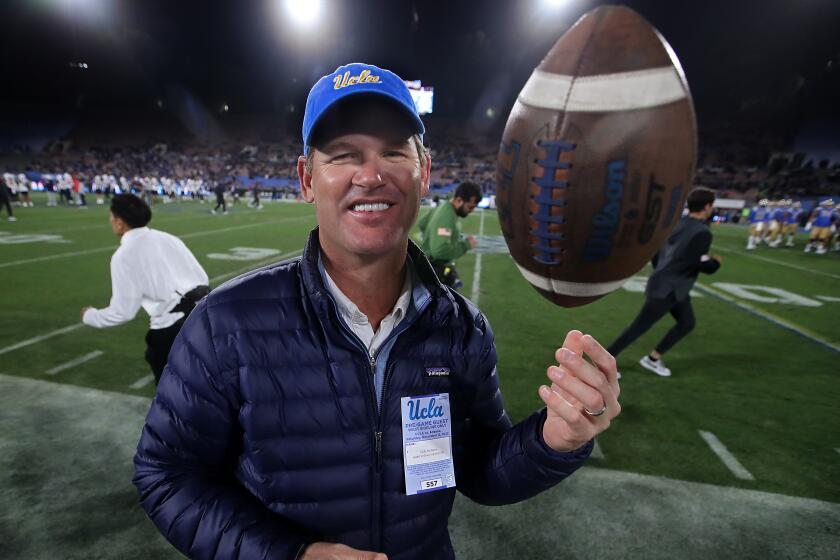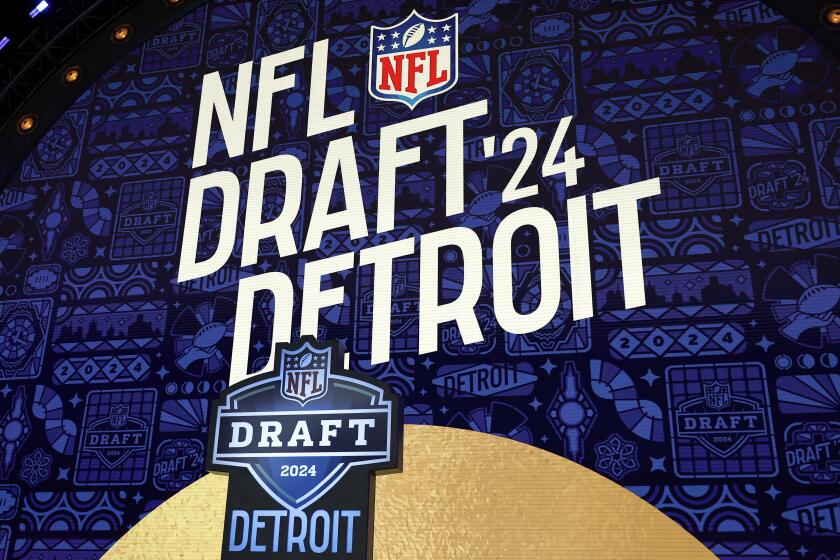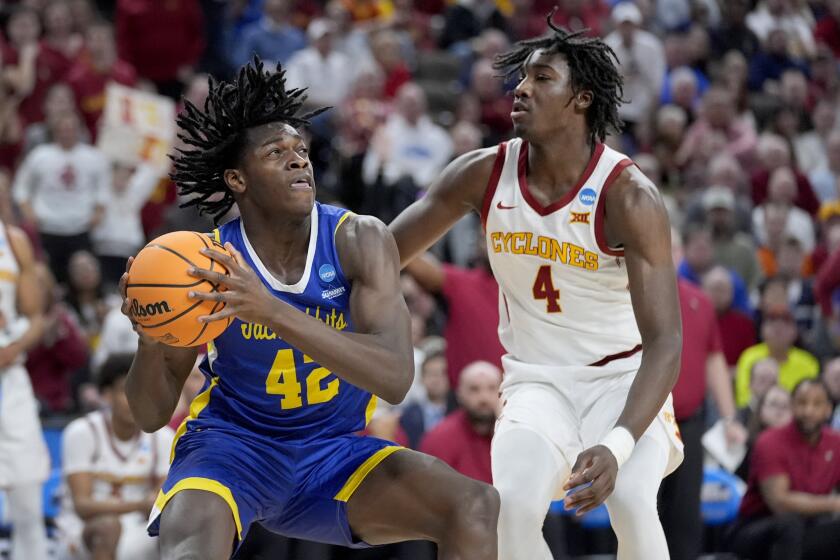Will a 45% Completion Mark Win Many Games in Pac-10? : UCLA Passing Isn’t Flunking
After it had failed so miserably in its major test against Oklahoma, UCLA’s passing game improved in what turned out to be nothing more than a pop quiz at San Diego State, so split end Flipper Anderson felt pretty safe in offering his opinion on Air Matt.
Anderson said that the Bruins’ air attack deserved a passing grade, but not much more.
“I’d give it a C,” Anderson said.
That evaluation forced a wry smile out of quarterback coach Homer Smith.
“I think he’s being too kind,” Smith said.
At UCLA, they prefer to run a balanced offensive attack, mixing runs and passes. This year, though, the people who carry the football are thought to be the strength of the Bruin team, so what does that make the passing game?
Right now, the UCLA passing game looks like a question on what could become a season-long quiz show: How many teams can the Bruins expect to beat by completing five passes?
At least one that we know of, because that’s how many were completed by quarterbacks Matt Stevens and Brendan McCracken in the Bruins’ 45-14 devastation of San Diego State Saturday night. Of course, UCLA didn’t really need to throw more than 13 against the Aztecs, and that could be true again Saturday night when the Bruins play another decided underdog, Cal State Long Beach.
UCLA will open its Pacific 10 schedule Oct. 4 against Arizona State; so in less than two weeks, the Bruins will need to be throwing the football as well as they run it.
“We all know we’ve got to be able to throw the football better, to mix up our offense more, and we’re going to try to do that a lot more,” Anderson said. “I think Matt was a little snake-bit at Oklahoma, but all of us were. We’re going to come around. We just didn’t have many chances to catch a lot of footballs Saturday night.”
Stevens completed only 4 of the 12 passes he threw against the Aztecs, but he deposited a couple of big ones into Anderson’s hands. A 50-yarder to the Aztec two-yard-line set up the second of Gaston Green’s three touchdown runs, right after San Diego State had pulled to within 10-7. Then, with only 13 seconds left in the half, Stevens threw a 40-yard touchdown pass to Anderson, a play that put the game out of reach, 31-7.
Both of the long passes were perfectly thrown by Stevens. Or, as Donahue chose to describe them: “They were a couple of mortar shots.”
The average distance for Stevens’ four completions was 29.75 yards. Donahue believes that to be an indication that Stevens feels more comfortable throwing deep than on the shorter routes. In two games, Stevens has completed 18 of 40 passes--45%--for 231 yards and a touchdown. He threw five interceptions at Oklahoma, but none at San Diego State.
Since the Oklahoma game, Stevens has been carrying some emotional baggage. A fifth-year senior and a team captain, he blamed himself for the loss at Norman, so his outlook improved considerably when Anderson caught that 50-yard pass.
“When I made that pass, I said to myself, ‘Thank God, I finally did something worthwhile,’ ” Stevens said.
Donahue, who has elevated worrying to an art form, said that the most important thing Stevens and the Bruins’ passing game must do is continue to improve, as it did from Game 1 to Game 2.
“We didn’t throw any interceptions and that’s encouraging,” Donahue said. “Obviously, Matt Stevens played a great deal better than he did at OU. As he plays more, he’ll do better. You know, Matt is a very experienced veteran player who hasn’t played very much. His time on the game field has been minuscule.
“We know we can’t just throw deep because you might not always get them. If those two long passes were incompletions, you could have subtracted 14 points off the scoreboard and the game might have been different. What were we? Four of 11 at the half? We’ve got to do better than that.”
With tight end Derek Tennell back in the starting lineup, Stevens has another big target, which should help him when he’s looking for other receivers on shorter routes. With 3 catches and 99 yards, Anderson is the leading UCLA receiver. He has high hopes that the Bruins are going to improve the passing game in the next few weeks. If it happens, then Anderson may also have had his wish granted.
“I want to catch more passes,” he said. “A whole bunch more of them.”
The Bruin offense isn’t Air Matt yet, but apparently they’re working on it.
Bruin Notes Fullback Marcus Greenwood reinjured his right ankle Saturday night and also twisted his left one and may not be able to play against Cal State Long Beach at the Rose Bowl Saturday night, Terry Donahue said. Guard Jim Alexander was forced out of the San Diego State game when he bruised his knee, but Donahue thinks the 259-pound senior will be ready to play against Long Beach. . . . Donahue said that tailback James Primus may also be asked to play fullback. Primus said he had already volunteered to do that. . . . One of the defenders Donahue singled out was linebacker Eric Smith, who had nine tackles against San Diego State, five of them for losses. . . . The Bruins’ Pac-10 opener against Arizona State Oct. 4 will begin at 11:30 a.m. at the Rose Bowl. . . . Long Beach is 1-1 after losing to San Diego State, 27-24, and defeating Western Michigan, 14-13. UCLA has beaten the 49ers twice in two previous meetings--41-10 in 1982 and 23-17 in 1984. . . . Sophomore quarterback Jeff Graham has thrown 93 passes in the two 49er games and completed 47 for 506 yards. . . . Mike Sheppard, the 49er coach, said his team respects the talent of the Bruins by their method of preparing for the game. “We’re loading up on Kryptonite,” Sheppard said. . . . Does this sound like a vote of confidence? Donahue was asked about the security of field goal kicker David Franey. “As long as he’s perfect, he’s got the job,” Donahue said. Franey has been perfect so far in two attempts.
Go beyond the scoreboard
Get the latest on L.A.'s teams in the daily Sports Report newsletter.
You may occasionally receive promotional content from the Los Angeles Times.



